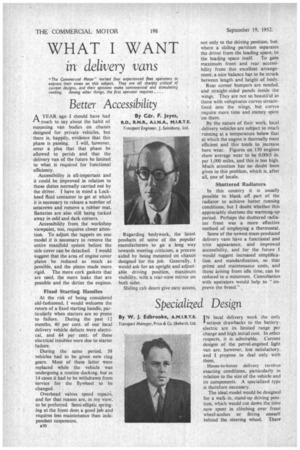Specialized Design
Page 64

Page 65

If you've noticed an error in this article please click here to report it so we can fix it.
By W. J. Edbrooke, A.M.I.R.T.E. I N local delivery work the only serious drawbacks to the batteryelectric are its limited range per charge and high initial cost. In other respects, it is admirable. Current designs of the petrol-engined light van are, however, less satisfactory, and I propose to deal only with them.
House-to-house delivery involves exacting conditions, particularly in relation to the size of the vehicle and its components. A specialized type is therefore necessary.
The ideal model would be designed for a walk-in, stand-up driving position, which would cut down the time now spent in climbing over front wheel-arches or fitting oneself behind the steering wheel. There should be sliding cab doors, with provision for fixing them in the open position, and the engine should be installed in such a manner that it can be changed in a maximum of two hours. A good position for it would be on the off side behind a fullfronted cab. Special attention should be paid to the accessibility of the distributor, fuel pump and starter.
Engine Requirements
As the rate of wear is high, the engine should have the following essential features: (1) Offset big-ends to allow for removal of the piston assembly from the top, and not by
juggling past the crankshaft. (2) Push-in liners (as fitted to a popular lightweight oil engine). (3) Hardened crankshaft and, as the clutch is operated about 500 times a day, provision for thrust and main bearings to be easily replaced. (4) Axialstarter to reduce flywheel tooth wear to .a minimum. (5) Dry clutch built to heavy-duty standards, with ballbearing release. Carbon thrust bearings are not efficient on this type of work.
No riveted chassis cross-members should be fitted directly behind the gearbox, as clutch repairs come under the heading of maintenance, and not dock overhaul, as is the case when one has to remove the engine just to reach the clutch.
Gearbox selectors should be fitted in the gearbox top for ease and speed of maintenance. The' hand brake and operating mechanism should be built to the highest standards to allow for at least 1,500 applications a week, and should be designed so that the pawl is not drawn over the quadrant on each occasion, but is engaged when the rods and cable are taut.
Reduce Lubrication
On the chassis, parts which require greasing should be kept to the minimum by the use of Silentbloc-type spring-eye bushes, and rubber universal joints are to be preferred.
Independent front-wheel suspension is not required, because of rapid tyre wear and because on new housing estates drivers are naturally inclined to go faster over bad rods than is possible with the solid-beam axle. Rear axles should be of the fully floating type and provision made for the crown-wheel pinion and differential to be assembled and meshed before fitting to the vehicle.
Attention to the points which I have mentioned would do much to reduce the operating cost of vans employed on local delivery work.




































































































































































